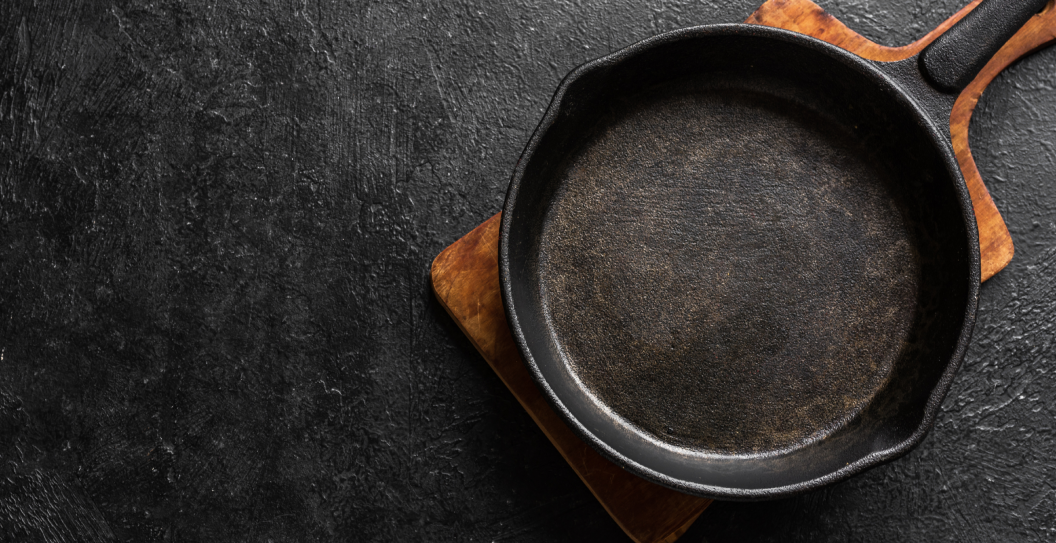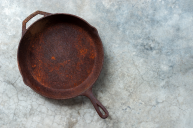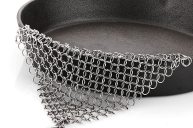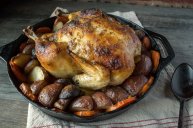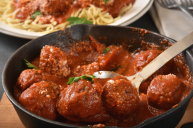If there's one piece of kitchenware we love most, it's a cast iron skillet. In addition to avoiding harmful chemical seepage, cast iron heats more evenly than other cookware. Cast iron's versatility is its true gift — you can make one-skillet meals, finish a steak in the oven, or bake a skillet dessert. They even work over an open fire when you want to cook supper under the stars.
Videos by Wide Open Country
Despite the advantages of cast iron skillets, they also have a downside. The process of cleaning, seasoning, and re-using a cast iron skillet can be tricky. Many of us have been told not to use soap, but how else can you remove old odors or residual stains? It feels like there are more theories on how to clean a cast iron skillet than there are skillets!
We're here to show you the best process for how to clean a cast iron skillet. You'll learn the cleaning process step-by-step and get answers on how to dry, re-season, and remove rust from the skillet. Discover additional tips on how to remove stubborn odors. You'll easily go from cooking savory dishes to baking a skillet cookie with total confidence!
What You'll Need
Depending on the method and how soiled the pan is, you can use the following tools:
- Sponge, scrubbing pad, or steel wool
- Dish soap (lye-free)
- Sea salt (for removing stubborn bits)
- Neutral cooking oil (canola or vegetable)
- Paper towels and/or clean dish towels
- Baking soda (when removing odors)
Step-By-Step Instructions on How To Clean a Cast Iron Skillet
It's important to distinguish between lightly soiled cast-iron skillets and those you've made a real mess with! If you own a set that includes two to three different-sized skillets, you may use them for specific dishes. With skillets that handle both sweet and savory dishes, read to the end to find out how to remove odors. Here are three basic methods for how to clean a cast iron skillet.
- For lightly soiled pans, use a neutral cooking oil to wipe out any bits with a paper towel and give it a good rub.
- When the skillet is clinging to bits of food, sprinkle a layer of sea salt into the pan after cooking. Pick up any remaining bits with a dish towel or rag and proceed with step number one above.
- For the most stubborn stuck-on food, try a scouring pad or a piece of steel wool, if necessary. Scrub with hot water and dry the skillet afterward (see how below!)
- The old rule about never letting soap touch your cast iron skillet doesn't apply as much today. This is because dish soaps used to contain lye, which was found to damage cast iron. Today's much gentler dish soaps work fine when used sparingly. Don't overload and make sure to dry the skillet completely.
How To Dry a Cast Iron Skillet
It's very important to fully dry your cast iron skillet after it gets wet. Using water is sometimes necessary, but the one thing you should avoid is letting the skillet soak. A cast iron skillet left to soak in water often gets stripped of its original seasoning. This is why drying is just as important when deciding how to clean a cast iron skillet.
To make sure you dry the skillet properly, wipe out the wet pan with paper towels. Then, cook the pan over medium to medium-high heat for a few minutes until it appears dry. Rub in a thin layer of neutral cooking oil and wipe away any excess. It's now ready for another round of cooking or baking!
How To Remove Rust From a Cast Iron Skillet
If you've got rust on your cast iron skillet, don't fret. It can be restored to its original condition with a few simple steps. Use steel wool or a scrubbing pad to remove any visible rust. Then, gently wash the skillet in hot water and a few drops of dish soap. Rinse thoroughly and dry completely, using the stovetop method. It may be a good time to thoroughly re-season the cast iron skillet. Keep reading to get the details on re-seasoning below.
How To Re-Season a Cast Iron Skillet
Re-seasoning is an important step for how to clean a cast iron skillet. You can easily re-season a skillet on your stovetop after cleaning it. Set the heat to medium-high and add neutral cooking oil to the pan. Coat the skillet completely and wipe away any excess oil. Heat it until it just begins to smoke and take it off the heat to cool.
For a complete re-seasoning of the pan, we recommend doing so as necessary. Some say once a month is a good rule of thumb, but it all depends on how often you use the skillet. If it appears dull, greasy, or rusty in parts, it's time to fully re-season your skillet.
When you want to re-season the skillet completely, add oil to the pan, distribute it, and wipe away any excess. Turn it over and bake the cast-iron skillet in a 350ºF oven for one hour. Let it cool completely in the oven before removing it.
Can You Cook Savory And Sweet Dishes In The Same Cast Iron Skillet?
There's nothing worse than making skillet brownies, only to discover they smell like onions (we know from experience!) There is no reason why you can't go from making savory dishes in a cast iron skillet to sweet ones. When odors are an issue, it's simple to handle.
Baking soda is the key here. It's wonderful for removing odors, which is why we place it in the fridge. Sprinkle baking soda over the cast iron skillet and leave it overnight. When the odors are super strong, like fish, make a paste using a 2:1 ratio of baking soda to water. Scrub the paste into the pan with a scrubbing brush or scouring pad.
Let the mixture sit for 5-10 minutes and rinse out the skillet. You might need to do this process twice when the smells are extreme. Re-season the pan on the stovetop or in the oven, so your cast-iron skillet is ready for more.
